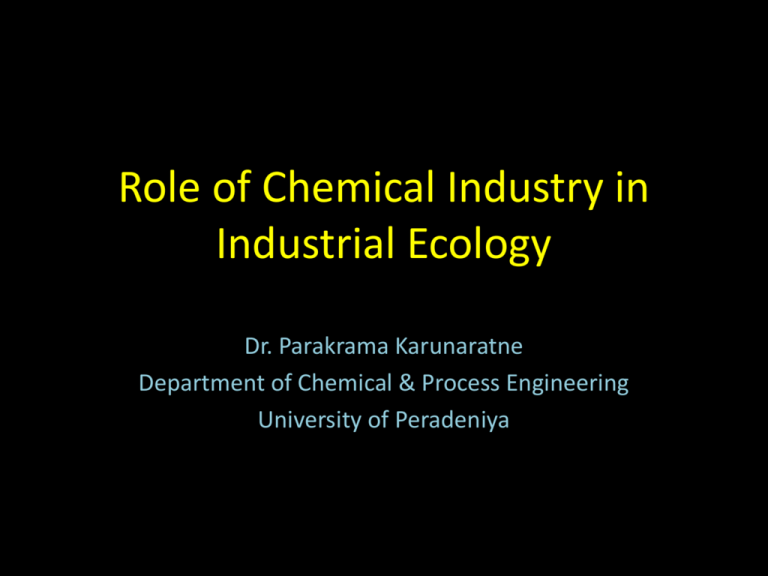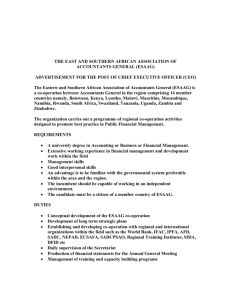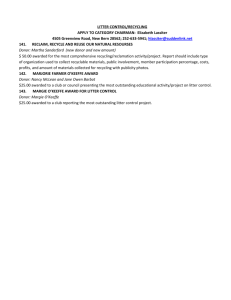Presentation
advertisement

Role of Chemical Industry in Industrial Ecology Dr. Parakrama Karunaratne Department of Chemical & Process Engineering University of Peradeniya Outline • • • • • • Issues with Present approach Concept of Industrial ecology & Symbiosis Examples IE and chemical Industry Methodology Barriers Industry – For a growing population Benefits... But... Degradation of the Environment .... Chemical Related Accidents... Depletion of Resources http://www.visualcapitalist.com/forecast-when-well-run-out-of-each-metal/ Challenging Environmental Issues... Learn from the best! Nature.. A result of millions of years of evolution . Nature..Full of interactions with mutual benefits (Symbiotic) Nature..Some times deadly, but no large scale chemical stocks Nature..There is nothing called waste Nature..Material flow is cyclic Learning from Nature... • Biomimicry – Innovations emulating nature • Symbiosis – Mutually beneficial relationships • Industrial Ecology – using principles of natural systems, to improve industrial systems to reduce their impact on the natural environment as well Industrial Ecology • Using principles of natural systems, to improve industrial systems so as to reduce their impact on the natural environment as well Industrial Ecology- correspondence of Two Systems Biosphere •Environment •Organism •Natural Product •Natural Selection •Ecosystem •Anabolism / Catabolism •Mutation and Selection •Succession •Adaptation •Food Web Technosphere •Market •Company •Industrial Product •Competition •Eco-Industrial Park •Manufacturing / Waste Management •Design for Environment •Economic Growth •Innovation •Product Life Cycle Wikipedia Ecosystem principles in industrial ecosystems Ecosystem Roundput Recycling of matter Cascading of energy Diversity Biodiversity Diversity in species, organisms Diversity in interdependency and co-operation Diversity in information Locality Utilising local resources Respecting the local natural limiting factors Local interdependency, co-operation Industrial system Roundput Recycling of matter Cascading of energy Diversity Diversity in actors, in interdependency and co-operation Diversity in industrial input, output Locality Utilising local resources Respecting the local natural limiting factors Co-operation between local actors Gradual change Gradual change Evolution using solar energy Using waste material and energy, Evolution through reproduction renewable resources Cyclical time, seasonal time Slow time rates in the Gradual development of the system development of system diversity diversity J. Korhonen / Journal of Cleaner Production 9 (2001) 253–259 IE at present... • At a primitive stage of evolution • Only first principle is applied to a limited extent (No waste in nature). • Making linear material flows circular • Use of waste materials and energy from one company as the input for another. (By-product Synergy) • Mostly systems evolves around an major industry such as refinery, power plant, or cement plant Types of material and energy loops • Type 1: classical recycling system of products at the end of their life, implying an interface collector and seller (household waste recycling systems) • Type 2: material and energy flow loop system within a factory or a company (Sugar factory) • Type 3: material and energy exchange system between neighbouring companies within a defined zone • Type 4: material and energy exchange system between local companies but not neighbouring (Kalundborg) • Type 5: material and energy exchange system between companies organized “virtually” at the scale of a region (North Carolina, Tampico) Examples.. Benefits Norrköping Industrial Symbiosis Network Styria Recycling System Hazardous Chemical Industry and IE • Mainly act as a donor rather than a receptor • Meeting purity and cost requirements is a challenge • Process changes to donor and receptor companies may be necessary • Probably processes mediation is needed between the donor and the receptor to modify waste of donor to meet receptor requirements • Needs R&D. Universities has played a vital role in IEP developments • System perspective is the key Hazardous Chemical Industry and IE • Recovery of solvents by intermediate parties take place • Leading chemical companies actively engaged in R&D, (Dow with EPA etc.,) • Will be forced to follow initiative like IE due to depleting resources and tightening regulations. Ignored problems would come knocking on your door one day! Examples -Dow • Forty Dow Chemical manufacturing units, including chemical, plastic, and agricultural products at six Gulf Coast facilities, participated in an intra-company BPS Network • Discovered 27 potential synergy opportunities involving six different technologies, translating to $15 million in potential annual cost savings • Diverted wastes include volatile materials such as spent solvents and hydrocarbons, sodium hydroxide by-products, sulfuric acid wastes, and hydrogen by-products Other Examples • Use of spent NaOH (recovered) in Kraft paper process • Rinse Styrene in Plastic industry as Resurfacing Material • Sulphur Dioxide Scrubber By-Products to Primary Ingredient in Gypsum • Waste Sulphuric acid used in wastewater pH adjustments • Steel slag used as a raw material for cement EEREnformaton Center Overall Benefits • • • • • • Increased revenues from by-product sales Reduction in waste disposal costs Substitution of lower-cost, locally sourced recycled feedstocks Reduction in solid waste and other environmental burdens Reduction in energy use and greenhouse gas emissions Reduced demand for virgin materials leading to resource conservation • Stimulation of regional entrepreneurship and economic development • Enhanced corporate reputation for sustainable practices • Interaction with other leading companies and technical experts Conditions that enable the sustainability.. 1. Nature is not subject to systematic increasing of concentrations of substances extracted from the Earth’s crust 2. Nature is not subject to systematic increasing of concentrations of substances produced by society 3. Nature is not subject to systematic increasing of degradation by physical means 4. Human needs are met worldwide IE Waste management hierarchy Receiver Prevent Reduce Reuse Donor Recycle Disposal IE should not be a life line for wasteful inefficient companies Waste management principles Priority should be for prevention and reduction – Inherent SHE, D4S, – Green Chemistry, Green engineering – Cleaner Production, Green Productivity – Chemical leasing Method 1. Identify material flows within a industrial zone, area or region (MFA) Zone/Area Method 2. Match possible input/outputs (Waste material and energy) Zone/Area Method 4. Start communication (Mediation may be needed) Facility 1 Facility 2 Method 4. Find out gaps and seek possible solutions Facility 1 Facility 2 Barriers... • Economic – No company wants IE unless it is a solution for their business problems • Technical - Purity/Purification • Lack of initial planning • Lack of pressure to change Future... Technology improvement Customer pressure Depleting Resources Industry Policy/ Regulations IE Summary • IE is applying ecological principles for industrial systems • At present in a primitive stage of evolution. Abrupt interventions may not work, but fast forward evolution is needed • Chemical industry is a difficult species in the system, but can be a donor. Should be converted into resource efficient, inherently safe species • IE is a good framework for achieving decoupling of economic growth & material consumption, (circular economy) and sustainability Thank you!






